Organisational Behaviour Report: Analysis of Nisa's Practices
VerifiedAdded on 2023/01/10
|16
|5072
|79
Report
AI Summary
This report provides an in-depth analysis of organisational behaviour, using Nisa, a medium-sized UK-based firm, as a case study. The report explores the impact of organisational culture, power, and politics on individual and team behaviour. It examines Handy's culture model and Jarrett's Political Terrain model to illustrate these concepts. Furthermore, the report evaluates the contribution of content (Maslow's hierarchy, Herzberg's, Alderfer's) and process theories (Expectancy, Equity, Locke and Latham) in achieving organisational goals by motivating employees. The report also discusses the difference between effective and ineffective teams, and the philosophy of organisational behaviour within teams in the context of a business situation. The report concludes with insights into how Nisa can optimize its practices for improved employee satisfaction and organisational success.
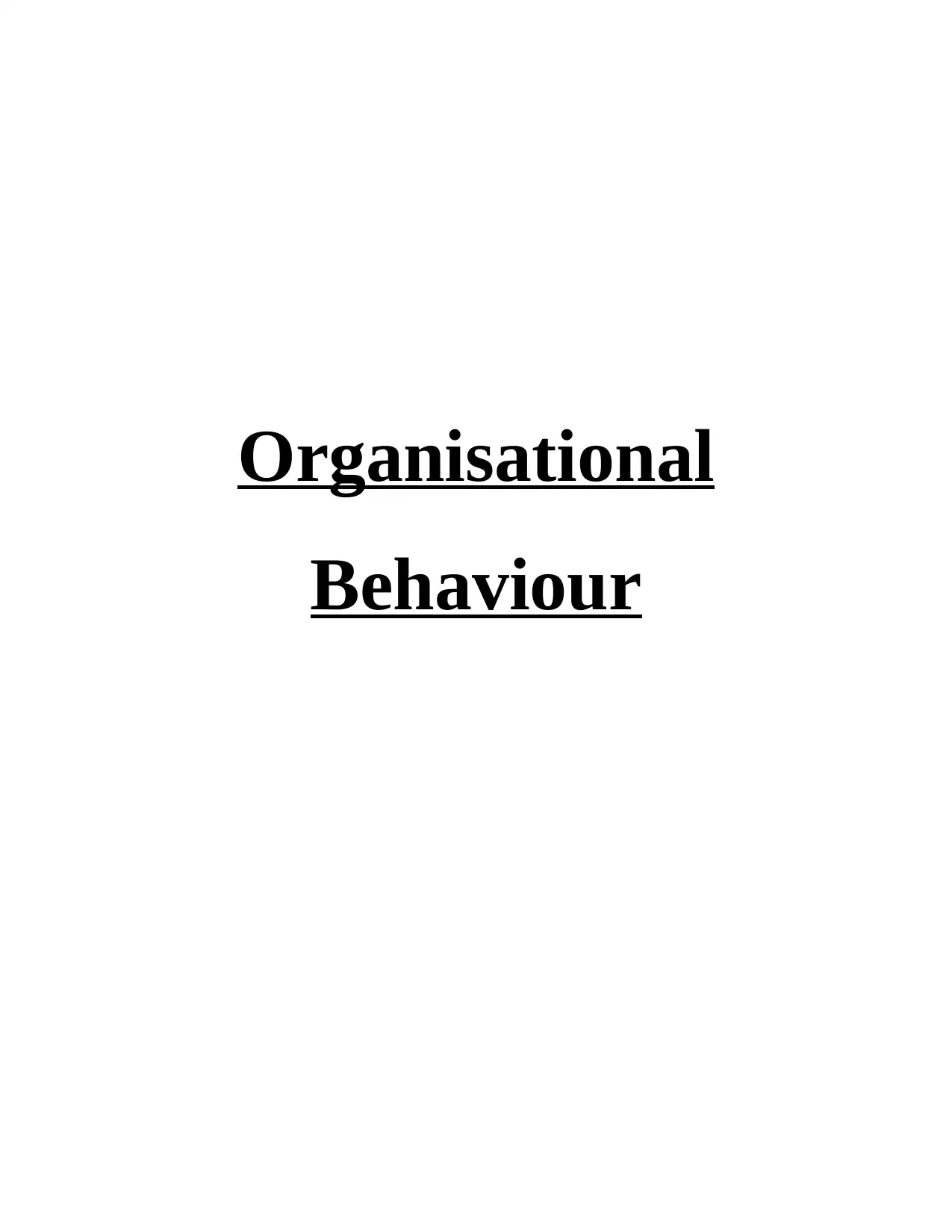
Organisational
Behaviour
Behaviour
Paraphrase This Document
Need a fresh take? Get an instant paraphrase of this document with our AI Paraphraser
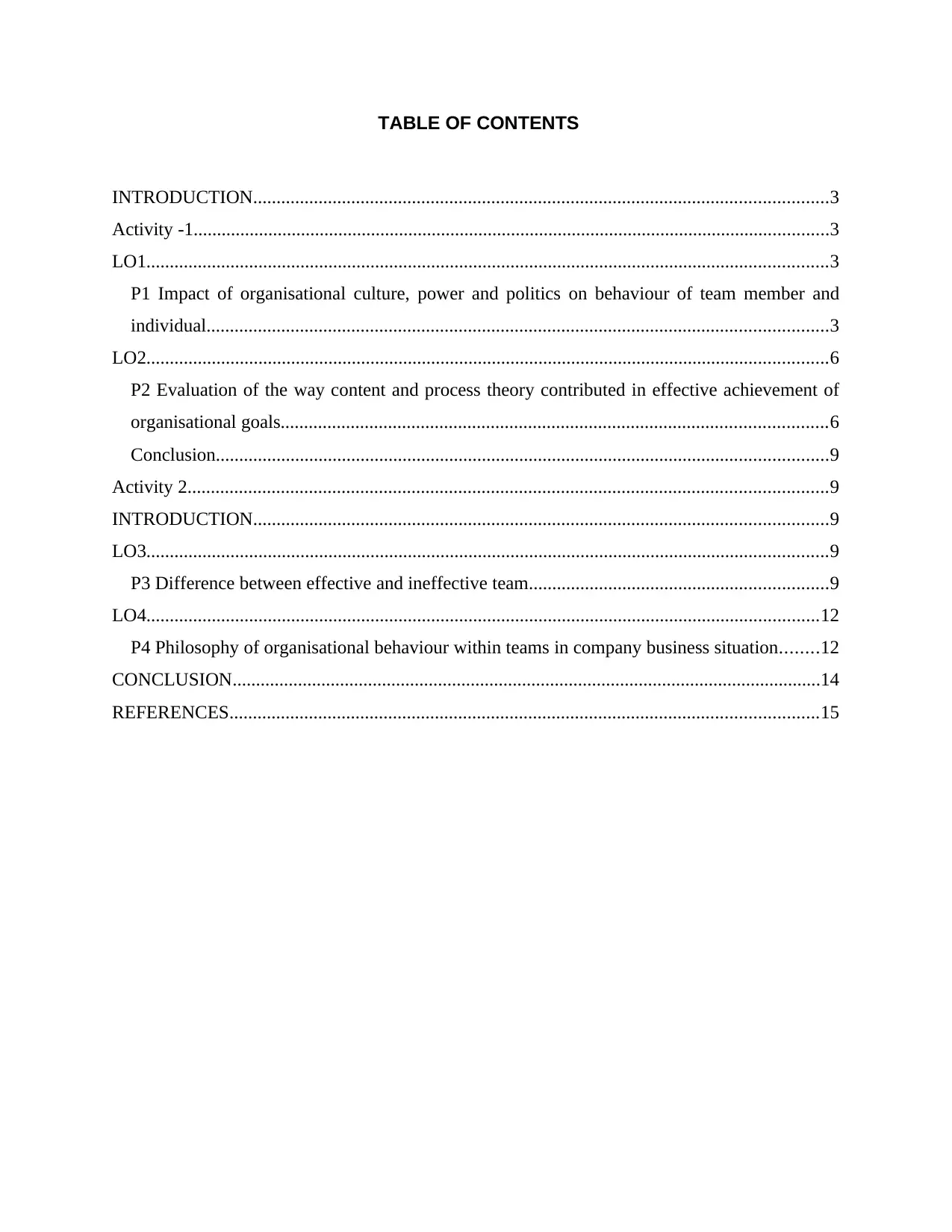
TABLE OF CONTENTS
INTRODUCTION...........................................................................................................................3
Activity -1........................................................................................................................................3
LO1..................................................................................................................................................3
P1 Impact of organisational culture, power and politics on behaviour of team member and
individual.....................................................................................................................................3
LO2..................................................................................................................................................6
P2 Evaluation of the way content and process theory contributed in effective achievement of
organisational goals.....................................................................................................................6
Conclusion...................................................................................................................................9
Activity 2.........................................................................................................................................9
INTRODUCTION...........................................................................................................................9
LO3..................................................................................................................................................9
P3 Difference between effective and ineffective team................................................................9
LO4................................................................................................................................................12
P4 Philosophy of organisational behaviour within teams in company business situation........12
CONCLUSION..............................................................................................................................14
REFERENCES..............................................................................................................................15
INTRODUCTION...........................................................................................................................3
Activity -1........................................................................................................................................3
LO1..................................................................................................................................................3
P1 Impact of organisational culture, power and politics on behaviour of team member and
individual.....................................................................................................................................3
LO2..................................................................................................................................................6
P2 Evaluation of the way content and process theory contributed in effective achievement of
organisational goals.....................................................................................................................6
Conclusion...................................................................................................................................9
Activity 2.........................................................................................................................................9
INTRODUCTION...........................................................................................................................9
LO3..................................................................................................................................................9
P3 Difference between effective and ineffective team................................................................9
LO4................................................................................................................................................12
P4 Philosophy of organisational behaviour within teams in company business situation........12
CONCLUSION..............................................................................................................................14
REFERENCES..............................................................................................................................15
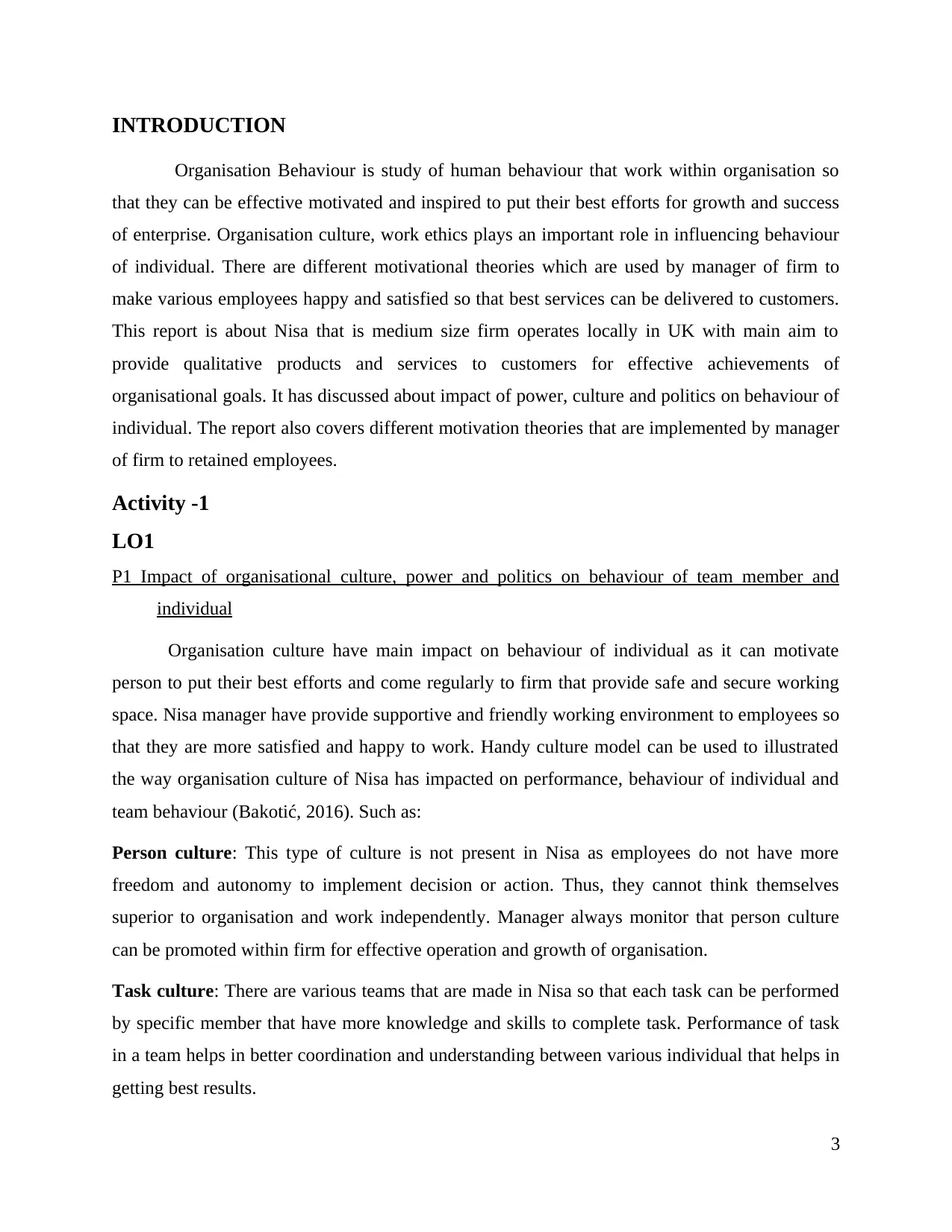
INTRODUCTION
Organisation Behaviour is study of human behaviour that work within organisation so
that they can be effective motivated and inspired to put their best efforts for growth and success
of enterprise. Organisation culture, work ethics plays an important role in influencing behaviour
of individual. There are different motivational theories which are used by manager of firm to
make various employees happy and satisfied so that best services can be delivered to customers.
This report is about Nisa that is medium size firm operates locally in UK with main aim to
provide qualitative products and services to customers for effective achievements of
organisational goals. It has discussed about impact of power, culture and politics on behaviour of
individual. The report also covers different motivation theories that are implemented by manager
of firm to retained employees.
Activity -1
LO1
P1 Impact of organisational culture, power and politics on behaviour of team member and
individual
Organisation culture have main impact on behaviour of individual as it can motivate
person to put their best efforts and come regularly to firm that provide safe and secure working
space. Nisa manager have provide supportive and friendly working environment to employees so
that they are more satisfied and happy to work. Handy culture model can be used to illustrated
the way organisation culture of Nisa has impacted on performance, behaviour of individual and
team behaviour (Bakotić, 2016). Such as:
Person culture: This type of culture is not present in Nisa as employees do not have more
freedom and autonomy to implement decision or action. Thus, they cannot think themselves
superior to organisation and work independently. Manager always monitor that person culture
can be promoted within firm for effective operation and growth of organisation.
Task culture: There are various teams that are made in Nisa so that each task can be performed
by specific member that have more knowledge and skills to complete task. Performance of task
in a team helps in better coordination and understanding between various individual that helps in
getting best results.
3
Organisation Behaviour is study of human behaviour that work within organisation so
that they can be effective motivated and inspired to put their best efforts for growth and success
of enterprise. Organisation culture, work ethics plays an important role in influencing behaviour
of individual. There are different motivational theories which are used by manager of firm to
make various employees happy and satisfied so that best services can be delivered to customers.
This report is about Nisa that is medium size firm operates locally in UK with main aim to
provide qualitative products and services to customers for effective achievements of
organisational goals. It has discussed about impact of power, culture and politics on behaviour of
individual. The report also covers different motivation theories that are implemented by manager
of firm to retained employees.
Activity -1
LO1
P1 Impact of organisational culture, power and politics on behaviour of team member and
individual
Organisation culture have main impact on behaviour of individual as it can motivate
person to put their best efforts and come regularly to firm that provide safe and secure working
space. Nisa manager have provide supportive and friendly working environment to employees so
that they are more satisfied and happy to work. Handy culture model can be used to illustrated
the way organisation culture of Nisa has impacted on performance, behaviour of individual and
team behaviour (Bakotić, 2016). Such as:
Person culture: This type of culture is not present in Nisa as employees do not have more
freedom and autonomy to implement decision or action. Thus, they cannot think themselves
superior to organisation and work independently. Manager always monitor that person culture
can be promoted within firm for effective operation and growth of organisation.
Task culture: There are various teams that are made in Nisa so that each task can be performed
by specific member that have more knowledge and skills to complete task. Performance of task
in a team helps in better coordination and understanding between various individual that helps in
getting best results.
3
⊘ This is a preview!⊘
Do you want full access?
Subscribe today to unlock all pages.

Trusted by 1+ million students worldwide
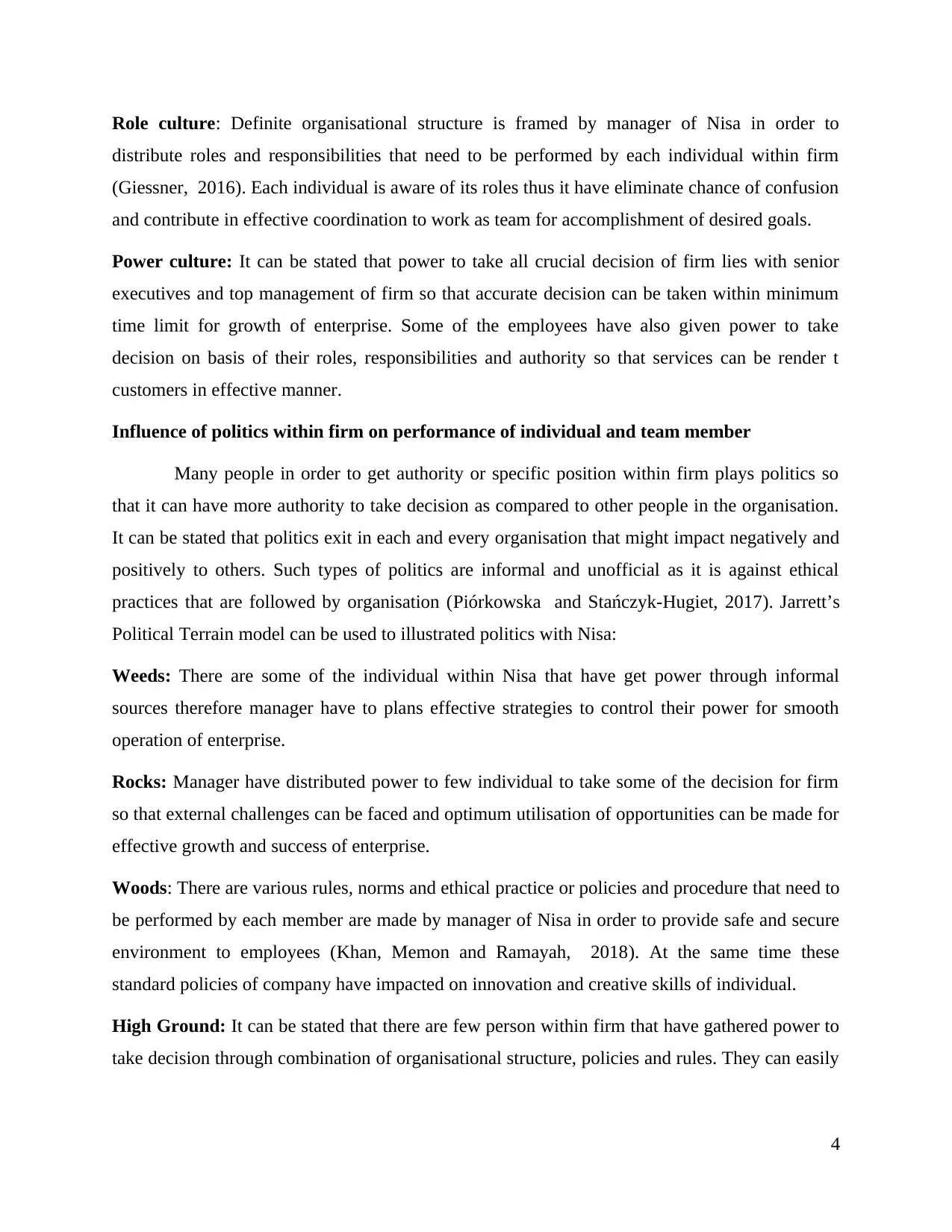
Role culture: Definite organisational structure is framed by manager of Nisa in order to
distribute roles and responsibilities that need to be performed by each individual within firm
(Giessner, 2016). Each individual is aware of its roles thus it have eliminate chance of confusion
and contribute in effective coordination to work as team for accomplishment of desired goals.
Power culture: It can be stated that power to take all crucial decision of firm lies with senior
executives and top management of firm so that accurate decision can be taken within minimum
time limit for growth of enterprise. Some of the employees have also given power to take
decision on basis of their roles, responsibilities and authority so that services can be render t
customers in effective manner.
Influence of politics within firm on performance of individual and team member
Many people in order to get authority or specific position within firm plays politics so
that it can have more authority to take decision as compared to other people in the organisation.
It can be stated that politics exit in each and every organisation that might impact negatively and
positively to others. Such types of politics are informal and unofficial as it is against ethical
practices that are followed by organisation (Piórkowska and Stańczyk-Hugiet, 2017). Jarrett’s
Political Terrain model can be used to illustrated politics with Nisa:
Weeds: There are some of the individual within Nisa that have get power through informal
sources therefore manager have to plans effective strategies to control their power for smooth
operation of enterprise.
Rocks: Manager have distributed power to few individual to take some of the decision for firm
so that external challenges can be faced and optimum utilisation of opportunities can be made for
effective growth and success of enterprise.
Woods: There are various rules, norms and ethical practice or policies and procedure that need to
be performed by each member are made by manager of Nisa in order to provide safe and secure
environment to employees (Khan, Memon and Ramayah, 2018). At the same time these
standard policies of company have impacted on innovation and creative skills of individual.
High Ground: It can be stated that there are few person within firm that have gathered power to
take decision through combination of organisational structure, policies and rules. They can easily
4
distribute roles and responsibilities that need to be performed by each individual within firm
(Giessner, 2016). Each individual is aware of its roles thus it have eliminate chance of confusion
and contribute in effective coordination to work as team for accomplishment of desired goals.
Power culture: It can be stated that power to take all crucial decision of firm lies with senior
executives and top management of firm so that accurate decision can be taken within minimum
time limit for growth of enterprise. Some of the employees have also given power to take
decision on basis of their roles, responsibilities and authority so that services can be render t
customers in effective manner.
Influence of politics within firm on performance of individual and team member
Many people in order to get authority or specific position within firm plays politics so
that it can have more authority to take decision as compared to other people in the organisation.
It can be stated that politics exit in each and every organisation that might impact negatively and
positively to others. Such types of politics are informal and unofficial as it is against ethical
practices that are followed by organisation (Piórkowska and Stańczyk-Hugiet, 2017). Jarrett’s
Political Terrain model can be used to illustrated politics with Nisa:
Weeds: There are some of the individual within Nisa that have get power through informal
sources therefore manager have to plans effective strategies to control their power for smooth
operation of enterprise.
Rocks: Manager have distributed power to few individual to take some of the decision for firm
so that external challenges can be faced and optimum utilisation of opportunities can be made for
effective growth and success of enterprise.
Woods: There are various rules, norms and ethical practice or policies and procedure that need to
be performed by each member are made by manager of Nisa in order to provide safe and secure
environment to employees (Khan, Memon and Ramayah, 2018). At the same time these
standard policies of company have impacted on innovation and creative skills of individual.
High Ground: It can be stated that there are few person within firm that have gathered power to
take decision through combination of organisational structure, policies and rules. They can easily
4
Paraphrase This Document
Need a fresh take? Get an instant paraphrase of this document with our AI Paraphraser
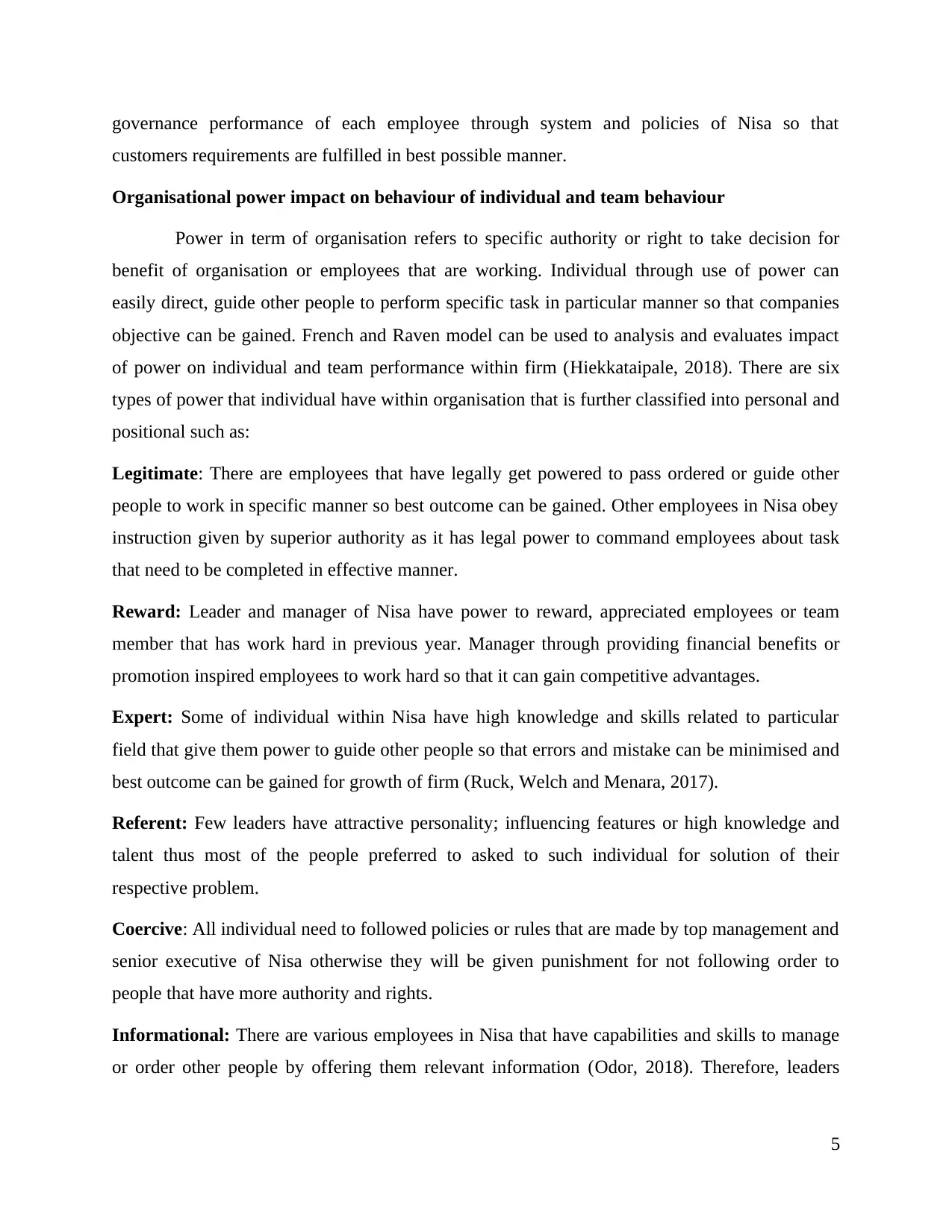
governance performance of each employee through system and policies of Nisa so that
customers requirements are fulfilled in best possible manner.
Organisational power impact on behaviour of individual and team behaviour
Power in term of organisation refers to specific authority or right to take decision for
benefit of organisation or employees that are working. Individual through use of power can
easily direct, guide other people to perform specific task in particular manner so that companies
objective can be gained. French and Raven model can be used to analysis and evaluates impact
of power on individual and team performance within firm (Hiekkataipale, 2018). There are six
types of power that individual have within organisation that is further classified into personal and
positional such as:
Legitimate: There are employees that have legally get powered to pass ordered or guide other
people to work in specific manner so best outcome can be gained. Other employees in Nisa obey
instruction given by superior authority as it has legal power to command employees about task
that need to be completed in effective manner.
Reward: Leader and manager of Nisa have power to reward, appreciated employees or team
member that has work hard in previous year. Manager through providing financial benefits or
promotion inspired employees to work hard so that it can gain competitive advantages.
Expert: Some of individual within Nisa have high knowledge and skills related to particular
field that give them power to guide other people so that errors and mistake can be minimised and
best outcome can be gained for growth of firm (Ruck, Welch and Menara, 2017).
Referent: Few leaders have attractive personality; influencing features or high knowledge and
talent thus most of the people preferred to asked to such individual for solution of their
respective problem.
Coercive: All individual need to followed policies or rules that are made by top management and
senior executive of Nisa otherwise they will be given punishment for not following order to
people that have more authority and rights.
Informational: There are various employees in Nisa that have capabilities and skills to manage
or order other people by offering them relevant information (Odor, 2018). Therefore, leaders
5
customers requirements are fulfilled in best possible manner.
Organisational power impact on behaviour of individual and team behaviour
Power in term of organisation refers to specific authority or right to take decision for
benefit of organisation or employees that are working. Individual through use of power can
easily direct, guide other people to perform specific task in particular manner so that companies
objective can be gained. French and Raven model can be used to analysis and evaluates impact
of power on individual and team performance within firm (Hiekkataipale, 2018). There are six
types of power that individual have within organisation that is further classified into personal and
positional such as:
Legitimate: There are employees that have legally get powered to pass ordered or guide other
people to work in specific manner so best outcome can be gained. Other employees in Nisa obey
instruction given by superior authority as it has legal power to command employees about task
that need to be completed in effective manner.
Reward: Leader and manager of Nisa have power to reward, appreciated employees or team
member that has work hard in previous year. Manager through providing financial benefits or
promotion inspired employees to work hard so that it can gain competitive advantages.
Expert: Some of individual within Nisa have high knowledge and skills related to particular
field that give them power to guide other people so that errors and mistake can be minimised and
best outcome can be gained for growth of firm (Ruck, Welch and Menara, 2017).
Referent: Few leaders have attractive personality; influencing features or high knowledge and
talent thus most of the people preferred to asked to such individual for solution of their
respective problem.
Coercive: All individual need to followed policies or rules that are made by top management and
senior executive of Nisa otherwise they will be given punishment for not following order to
people that have more authority and rights.
Informational: There are various employees in Nisa that have capabilities and skills to manage
or order other people by offering them relevant information (Odor, 2018). Therefore, leaders
5
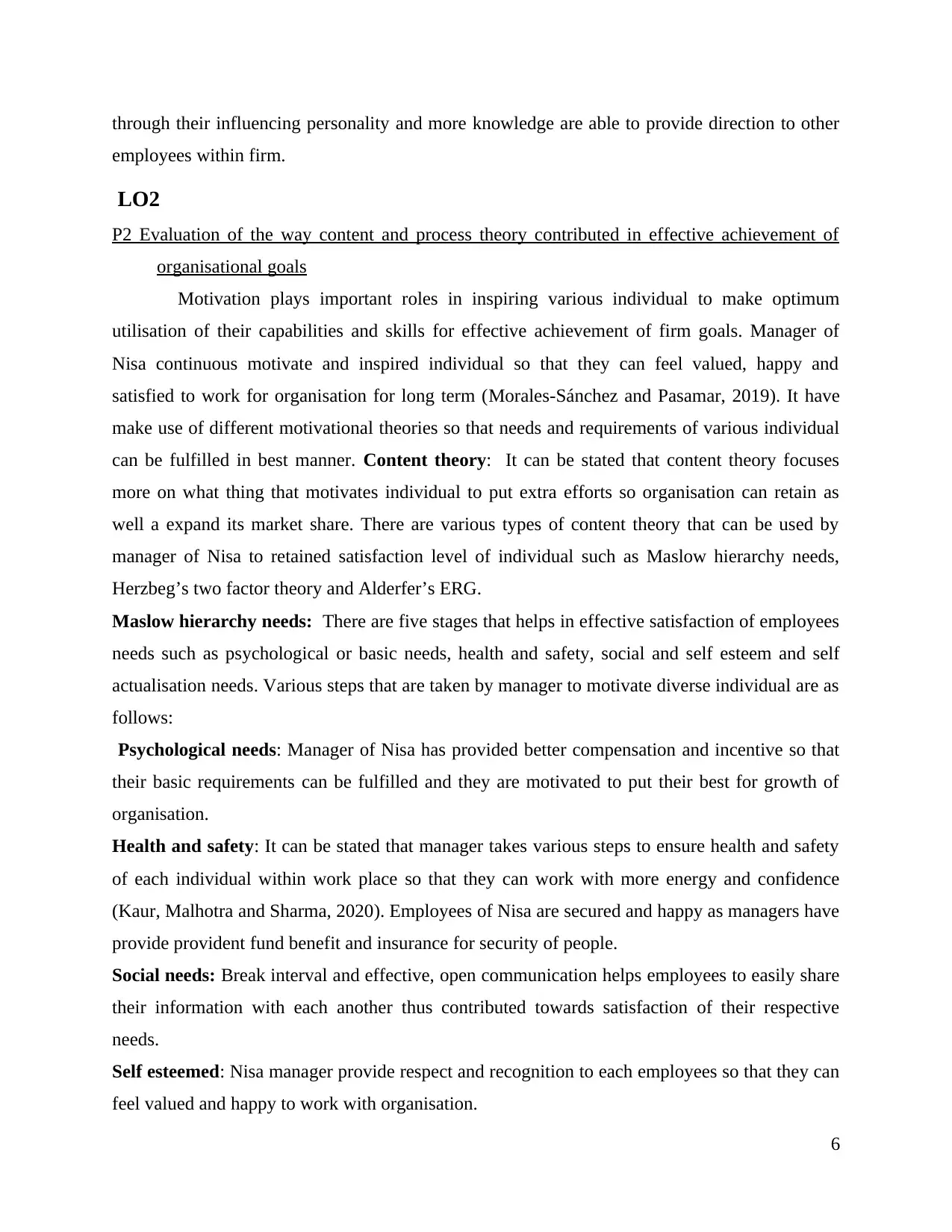
through their influencing personality and more knowledge are able to provide direction to other
employees within firm.
LO2
P2 Evaluation of the way content and process theory contributed in effective achievement of
organisational goals
Motivation plays important roles in inspiring various individual to make optimum
utilisation of their capabilities and skills for effective achievement of firm goals. Manager of
Nisa continuous motivate and inspired individual so that they can feel valued, happy and
satisfied to work for organisation for long term (Morales-Sánchez and Pasamar, 2019). It have
make use of different motivational theories so that needs and requirements of various individual
can be fulfilled in best manner. Content theory: It can be stated that content theory focuses
more on what thing that motivates individual to put extra efforts so organisation can retain as
well a expand its market share. There are various types of content theory that can be used by
manager of Nisa to retained satisfaction level of individual such as Maslow hierarchy needs,
Herzbeg’s two factor theory and Alderfer’s ERG.
Maslow hierarchy needs: There are five stages that helps in effective satisfaction of employees
needs such as psychological or basic needs, health and safety, social and self esteem and self
actualisation needs. Various steps that are taken by manager to motivate diverse individual are as
follows:
Psychological needs: Manager of Nisa has provided better compensation and incentive so that
their basic requirements can be fulfilled and they are motivated to put their best for growth of
organisation.
Health and safety: It can be stated that manager takes various steps to ensure health and safety
of each individual within work place so that they can work with more energy and confidence
(Kaur, Malhotra and Sharma, 2020). Employees of Nisa are secured and happy as managers have
provide provident fund benefit and insurance for security of people.
Social needs: Break interval and effective, open communication helps employees to easily share
their information with each another thus contributed towards satisfaction of their respective
needs.
Self esteemed: Nisa manager provide respect and recognition to each employees so that they can
feel valued and happy to work with organisation.
6
employees within firm.
LO2
P2 Evaluation of the way content and process theory contributed in effective achievement of
organisational goals
Motivation plays important roles in inspiring various individual to make optimum
utilisation of their capabilities and skills for effective achievement of firm goals. Manager of
Nisa continuous motivate and inspired individual so that they can feel valued, happy and
satisfied to work for organisation for long term (Morales-Sánchez and Pasamar, 2019). It have
make use of different motivational theories so that needs and requirements of various individual
can be fulfilled in best manner. Content theory: It can be stated that content theory focuses
more on what thing that motivates individual to put extra efforts so organisation can retain as
well a expand its market share. There are various types of content theory that can be used by
manager of Nisa to retained satisfaction level of individual such as Maslow hierarchy needs,
Herzbeg’s two factor theory and Alderfer’s ERG.
Maslow hierarchy needs: There are five stages that helps in effective satisfaction of employees
needs such as psychological or basic needs, health and safety, social and self esteem and self
actualisation needs. Various steps that are taken by manager to motivate diverse individual are as
follows:
Psychological needs: Manager of Nisa has provided better compensation and incentive so that
their basic requirements can be fulfilled and they are motivated to put their best for growth of
organisation.
Health and safety: It can be stated that manager takes various steps to ensure health and safety
of each individual within work place so that they can work with more energy and confidence
(Kaur, Malhotra and Sharma, 2020). Employees of Nisa are secured and happy as managers have
provide provident fund benefit and insurance for security of people.
Social needs: Break interval and effective, open communication helps employees to easily share
their information with each another thus contributed towards satisfaction of their respective
needs.
Self esteemed: Nisa manager provide respect and recognition to each employees so that they can
feel valued and happy to work with organisation.
6
⊘ This is a preview!⊘
Do you want full access?
Subscribe today to unlock all pages.

Trusted by 1+ million students worldwide
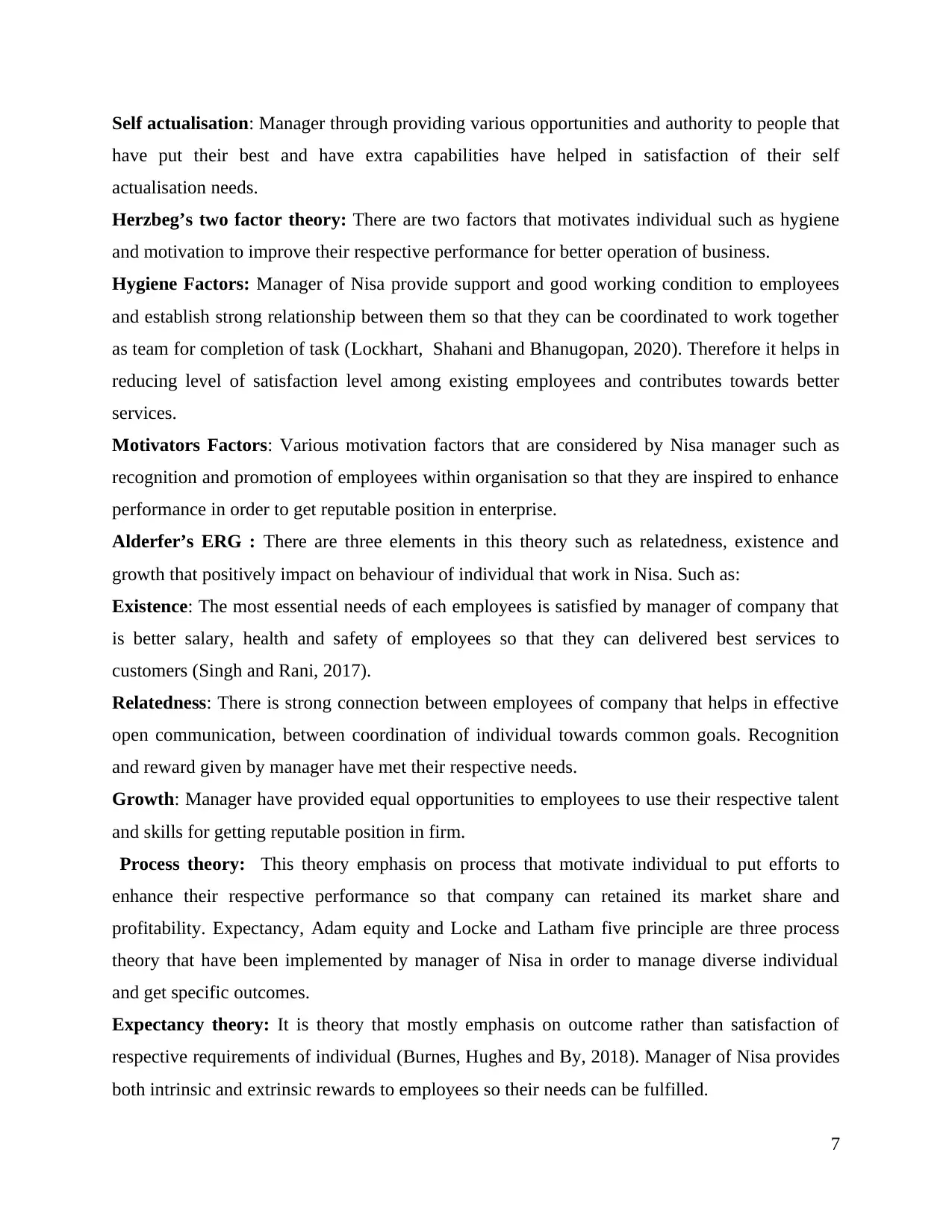
Self actualisation: Manager through providing various opportunities and authority to people that
have put their best and have extra capabilities have helped in satisfaction of their self
actualisation needs.
Herzbeg’s two factor theory: There are two factors that motivates individual such as hygiene
and motivation to improve their respective performance for better operation of business.
Hygiene Factors: Manager of Nisa provide support and good working condition to employees
and establish strong relationship between them so that they can be coordinated to work together
as team for completion of task (Lockhart, Shahani and Bhanugopan, 2020). Therefore it helps in
reducing level of satisfaction level among existing employees and contributes towards better
services.
Motivators Factors: Various motivation factors that are considered by Nisa manager such as
recognition and promotion of employees within organisation so that they are inspired to enhance
performance in order to get reputable position in enterprise.
Alderfer’s ERG : There are three elements in this theory such as relatedness, existence and
growth that positively impact on behaviour of individual that work in Nisa. Such as:
Existence: The most essential needs of each employees is satisfied by manager of company that
is better salary, health and safety of employees so that they can delivered best services to
customers (Singh and Rani, 2017).
Relatedness: There is strong connection between employees of company that helps in effective
open communication, between coordination of individual towards common goals. Recognition
and reward given by manager have met their respective needs.
Growth: Manager have provided equal opportunities to employees to use their respective talent
and skills for getting reputable position in firm.
Process theory: This theory emphasis on process that motivate individual to put efforts to
enhance their respective performance so that company can retained its market share and
profitability. Expectancy, Adam equity and Locke and Latham five principle are three process
theory that have been implemented by manager of Nisa in order to manage diverse individual
and get specific outcomes.
Expectancy theory: It is theory that mostly emphasis on outcome rather than satisfaction of
respective requirements of individual (Burnes, Hughes and By, 2018). Manager of Nisa provides
both intrinsic and extrinsic rewards to employees so their needs can be fulfilled.
7
have put their best and have extra capabilities have helped in satisfaction of their self
actualisation needs.
Herzbeg’s two factor theory: There are two factors that motivates individual such as hygiene
and motivation to improve their respective performance for better operation of business.
Hygiene Factors: Manager of Nisa provide support and good working condition to employees
and establish strong relationship between them so that they can be coordinated to work together
as team for completion of task (Lockhart, Shahani and Bhanugopan, 2020). Therefore it helps in
reducing level of satisfaction level among existing employees and contributes towards better
services.
Motivators Factors: Various motivation factors that are considered by Nisa manager such as
recognition and promotion of employees within organisation so that they are inspired to enhance
performance in order to get reputable position in enterprise.
Alderfer’s ERG : There are three elements in this theory such as relatedness, existence and
growth that positively impact on behaviour of individual that work in Nisa. Such as:
Existence: The most essential needs of each employees is satisfied by manager of company that
is better salary, health and safety of employees so that they can delivered best services to
customers (Singh and Rani, 2017).
Relatedness: There is strong connection between employees of company that helps in effective
open communication, between coordination of individual towards common goals. Recognition
and reward given by manager have met their respective needs.
Growth: Manager have provided equal opportunities to employees to use their respective talent
and skills for getting reputable position in firm.
Process theory: This theory emphasis on process that motivate individual to put efforts to
enhance their respective performance so that company can retained its market share and
profitability. Expectancy, Adam equity and Locke and Latham five principle are three process
theory that have been implemented by manager of Nisa in order to manage diverse individual
and get specific outcomes.
Expectancy theory: It is theory that mostly emphasis on outcome rather than satisfaction of
respective requirements of individual (Burnes, Hughes and By, 2018). Manager of Nisa provides
both intrinsic and extrinsic rewards to employees so their needs can be fulfilled.
7
Paraphrase This Document
Need a fresh take? Get an instant paraphrase of this document with our AI Paraphraser
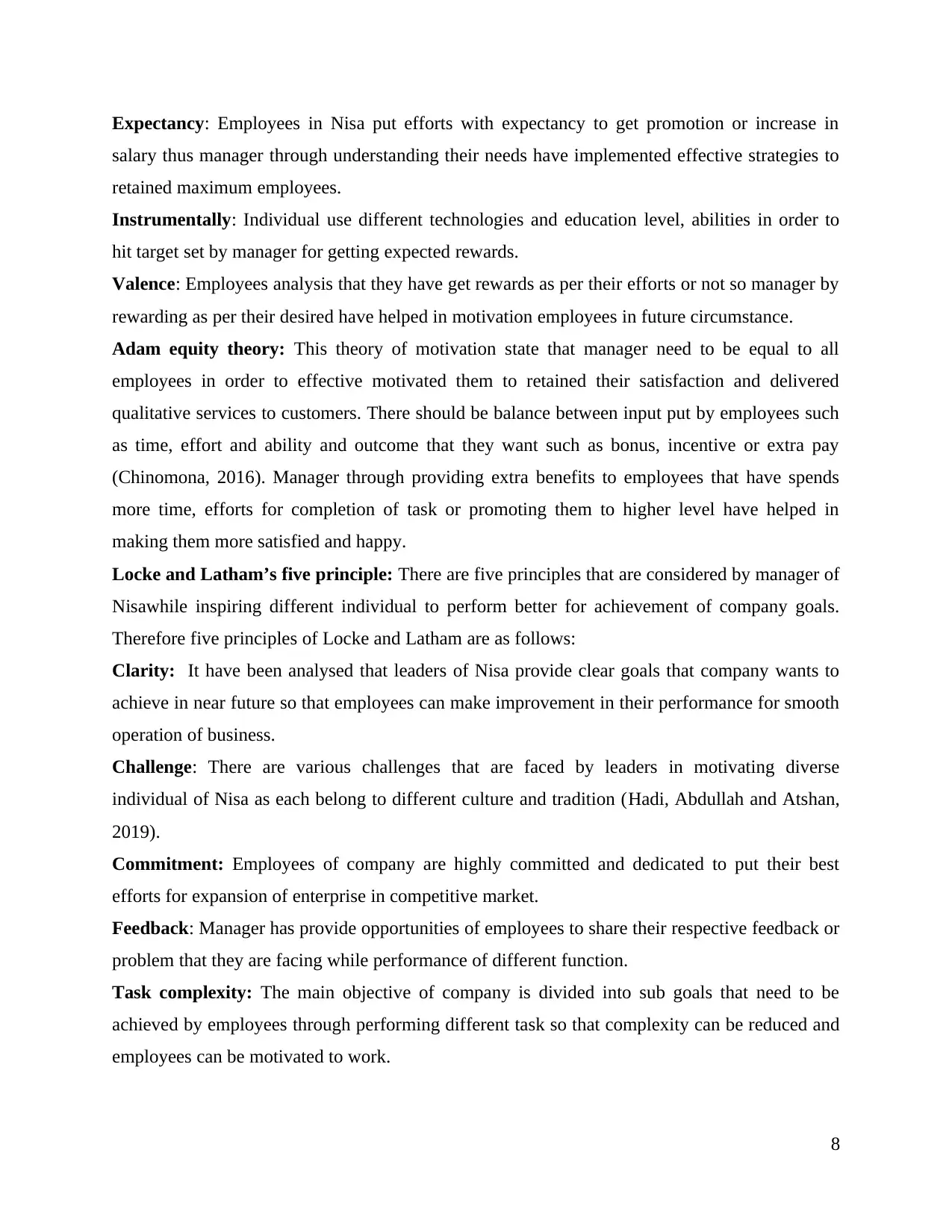
Expectancy: Employees in Nisa put efforts with expectancy to get promotion or increase in
salary thus manager through understanding their needs have implemented effective strategies to
retained maximum employees.
Instrumentally: Individual use different technologies and education level, abilities in order to
hit target set by manager for getting expected rewards.
Valence: Employees analysis that they have get rewards as per their efforts or not so manager by
rewarding as per their desired have helped in motivation employees in future circumstance.
Adam equity theory: This theory of motivation state that manager need to be equal to all
employees in order to effective motivated them to retained their satisfaction and delivered
qualitative services to customers. There should be balance between input put by employees such
as time, effort and ability and outcome that they want such as bonus, incentive or extra pay
(Chinomona, 2016). Manager through providing extra benefits to employees that have spends
more time, efforts for completion of task or promoting them to higher level have helped in
making them more satisfied and happy.
Locke and Latham’s five principle: There are five principles that are considered by manager of
Nisawhile inspiring different individual to perform better for achievement of company goals.
Therefore five principles of Locke and Latham are as follows:
Clarity: It have been analysed that leaders of Nisa provide clear goals that company wants to
achieve in near future so that employees can make improvement in their performance for smooth
operation of business.
Challenge: There are various challenges that are faced by leaders in motivating diverse
individual of Nisa as each belong to different culture and tradition (Hadi, Abdullah and Atshan,
2019).
Commitment: Employees of company are highly committed and dedicated to put their best
efforts for expansion of enterprise in competitive market.
Feedback: Manager has provide opportunities of employees to share their respective feedback or
problem that they are facing while performance of different function.
Task complexity: The main objective of company is divided into sub goals that need to be
achieved by employees through performing different task so that complexity can be reduced and
employees can be motivated to work.
8
salary thus manager through understanding their needs have implemented effective strategies to
retained maximum employees.
Instrumentally: Individual use different technologies and education level, abilities in order to
hit target set by manager for getting expected rewards.
Valence: Employees analysis that they have get rewards as per their efforts or not so manager by
rewarding as per their desired have helped in motivation employees in future circumstance.
Adam equity theory: This theory of motivation state that manager need to be equal to all
employees in order to effective motivated them to retained their satisfaction and delivered
qualitative services to customers. There should be balance between input put by employees such
as time, effort and ability and outcome that they want such as bonus, incentive or extra pay
(Chinomona, 2016). Manager through providing extra benefits to employees that have spends
more time, efforts for completion of task or promoting them to higher level have helped in
making them more satisfied and happy.
Locke and Latham’s five principle: There are five principles that are considered by manager of
Nisawhile inspiring different individual to perform better for achievement of company goals.
Therefore five principles of Locke and Latham are as follows:
Clarity: It have been analysed that leaders of Nisa provide clear goals that company wants to
achieve in near future so that employees can make improvement in their performance for smooth
operation of business.
Challenge: There are various challenges that are faced by leaders in motivating diverse
individual of Nisa as each belong to different culture and tradition (Hadi, Abdullah and Atshan,
2019).
Commitment: Employees of company are highly committed and dedicated to put their best
efforts for expansion of enterprise in competitive market.
Feedback: Manager has provide opportunities of employees to share their respective feedback or
problem that they are facing while performance of different function.
Task complexity: The main objective of company is divided into sub goals that need to be
achieved by employees through performing different task so that complexity can be reduced and
employees can be motivated to work.
8
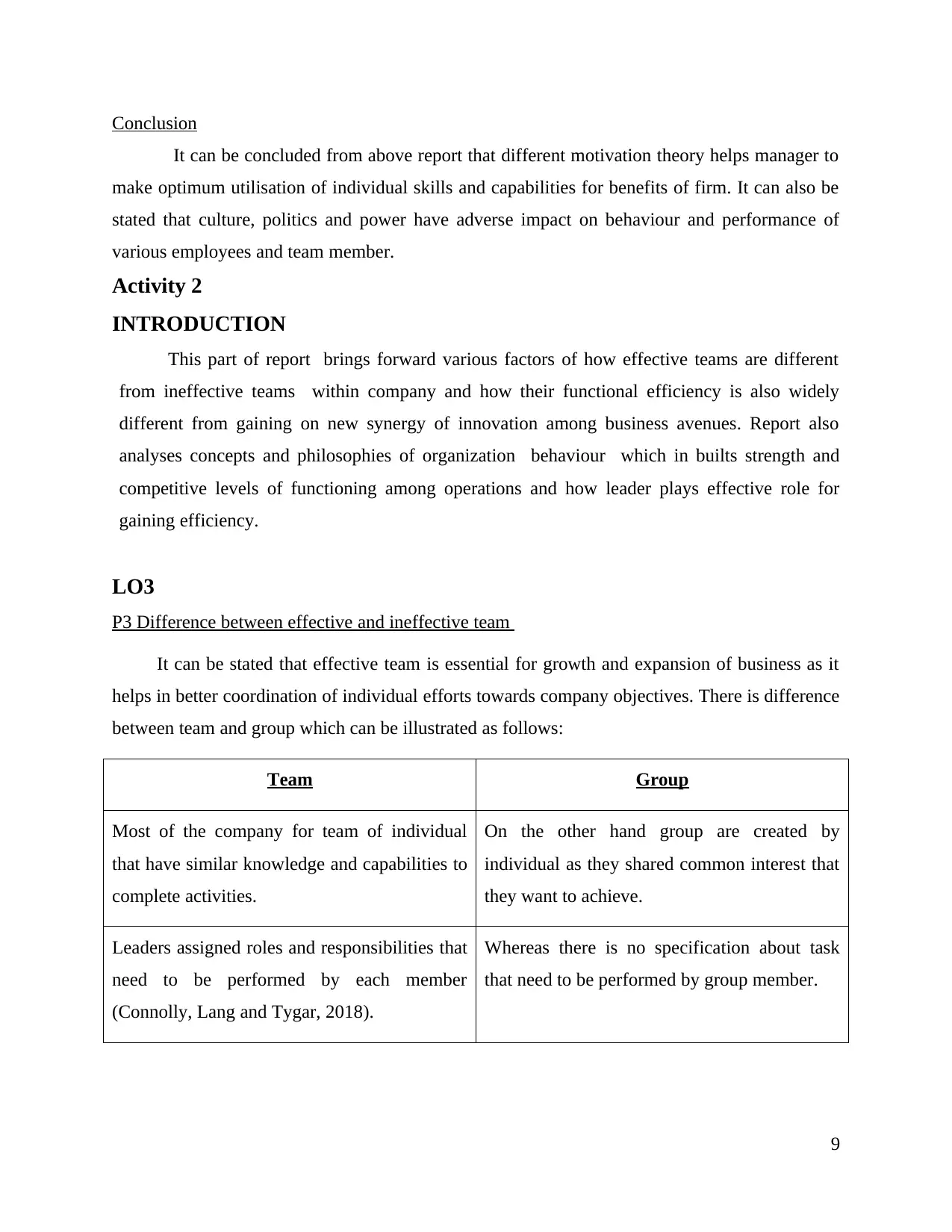
Conclusion
It can be concluded from above report that different motivation theory helps manager to
make optimum utilisation of individual skills and capabilities for benefits of firm. It can also be
stated that culture, politics and power have adverse impact on behaviour and performance of
various employees and team member.
Activity 2
INTRODUCTION
This part of report brings forward various factors of how effective teams are different
from ineffective teams within company and how their functional efficiency is also widely
different from gaining on new synergy of innovation among business avenues. Report also
analyses concepts and philosophies of organization behaviour which in builts strength and
competitive levels of functioning among operations and how leader plays effective role for
gaining efficiency.
LO3
P3 Difference between effective and ineffective team
It can be stated that effective team is essential for growth and expansion of business as it
helps in better coordination of individual efforts towards company objectives. There is difference
between team and group which can be illustrated as follows:
Team Group
Most of the company for team of individual
that have similar knowledge and capabilities to
complete activities.
On the other hand group are created by
individual as they shared common interest that
they want to achieve.
Leaders assigned roles and responsibilities that
need to be performed by each member
(Connolly, Lang and Tygar, 2018).
Whereas there is no specification about task
that need to be performed by group member.
9
It can be concluded from above report that different motivation theory helps manager to
make optimum utilisation of individual skills and capabilities for benefits of firm. It can also be
stated that culture, politics and power have adverse impact on behaviour and performance of
various employees and team member.
Activity 2
INTRODUCTION
This part of report brings forward various factors of how effective teams are different
from ineffective teams within company and how their functional efficiency is also widely
different from gaining on new synergy of innovation among business avenues. Report also
analyses concepts and philosophies of organization behaviour which in builts strength and
competitive levels of functioning among operations and how leader plays effective role for
gaining efficiency.
LO3
P3 Difference between effective and ineffective team
It can be stated that effective team is essential for growth and expansion of business as it
helps in better coordination of individual efforts towards company objectives. There is difference
between team and group which can be illustrated as follows:
Team Group
Most of the company for team of individual
that have similar knowledge and capabilities to
complete activities.
On the other hand group are created by
individual as they shared common interest that
they want to achieve.
Leaders assigned roles and responsibilities that
need to be performed by each member
(Connolly, Lang and Tygar, 2018).
Whereas there is no specification about task
that need to be performed by group member.
9
⊘ This is a preview!⊘
Do you want full access?
Subscribe today to unlock all pages.

Trusted by 1+ million students worldwide
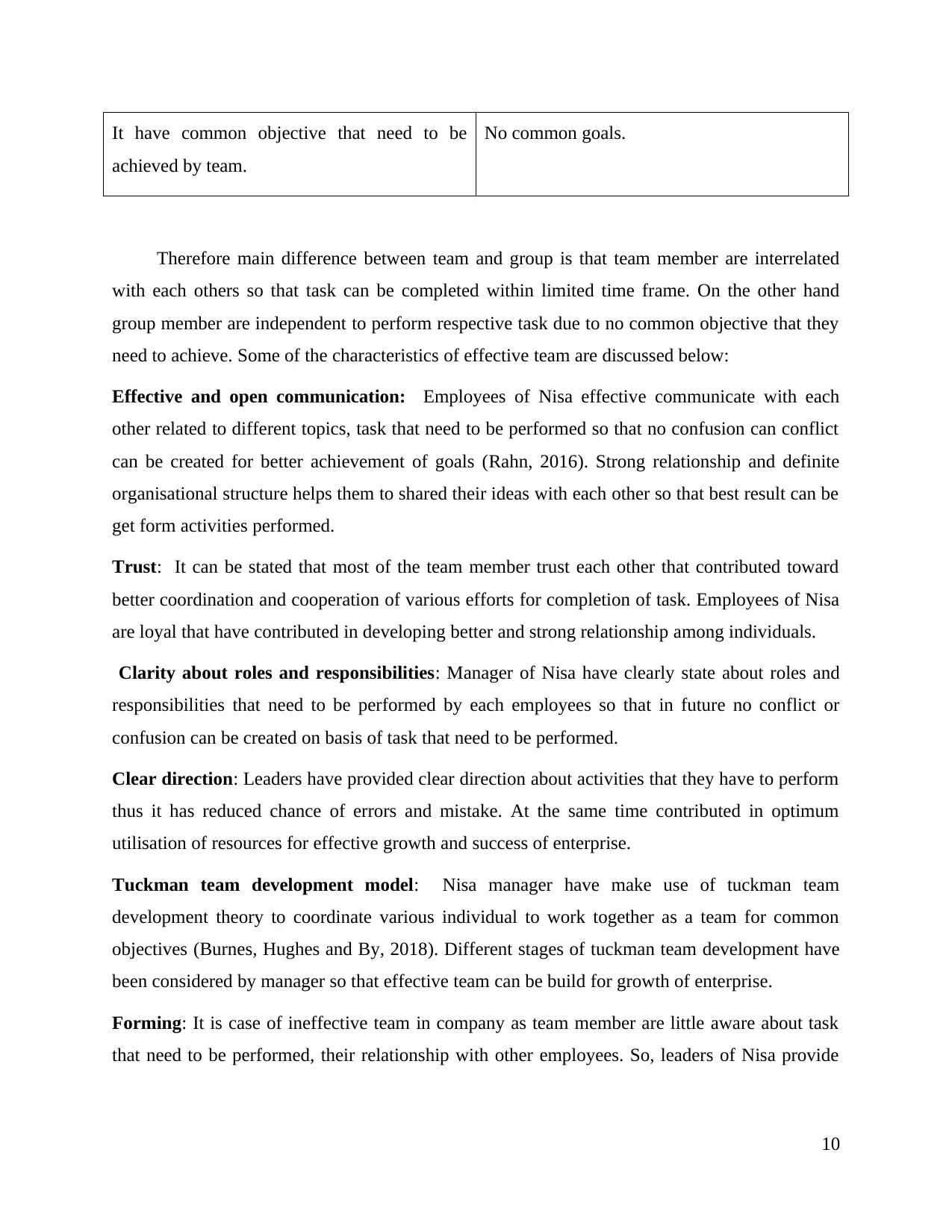
It have common objective that need to be
achieved by team.
No common goals.
Therefore main difference between team and group is that team member are interrelated
with each others so that task can be completed within limited time frame. On the other hand
group member are independent to perform respective task due to no common objective that they
need to achieve. Some of the characteristics of effective team are discussed below:
Effective and open communication: Employees of Nisa effective communicate with each
other related to different topics, task that need to be performed so that no confusion can conflict
can be created for better achievement of goals (Rahn, 2016). Strong relationship and definite
organisational structure helps them to shared their ideas with each other so that best result can be
get form activities performed.
Trust: It can be stated that most of the team member trust each other that contributed toward
better coordination and cooperation of various efforts for completion of task. Employees of Nisa
are loyal that have contributed in developing better and strong relationship among individuals.
Clarity about roles and responsibilities: Manager of Nisa have clearly state about roles and
responsibilities that need to be performed by each employees so that in future no conflict or
confusion can be created on basis of task that need to be performed.
Clear direction: Leaders have provided clear direction about activities that they have to perform
thus it has reduced chance of errors and mistake. At the same time contributed in optimum
utilisation of resources for effective growth and success of enterprise.
Tuckman team development model: Nisa manager have make use of tuckman team
development theory to coordinate various individual to work together as a team for common
objectives (Burnes, Hughes and By, 2018). Different stages of tuckman team development have
been considered by manager so that effective team can be build for growth of enterprise.
Forming: It is case of ineffective team in company as team member are little aware about task
that need to be performed, their relationship with other employees. So, leaders of Nisa provide
10
achieved by team.
No common goals.
Therefore main difference between team and group is that team member are interrelated
with each others so that task can be completed within limited time frame. On the other hand
group member are independent to perform respective task due to no common objective that they
need to achieve. Some of the characteristics of effective team are discussed below:
Effective and open communication: Employees of Nisa effective communicate with each
other related to different topics, task that need to be performed so that no confusion can conflict
can be created for better achievement of goals (Rahn, 2016). Strong relationship and definite
organisational structure helps them to shared their ideas with each other so that best result can be
get form activities performed.
Trust: It can be stated that most of the team member trust each other that contributed toward
better coordination and cooperation of various efforts for completion of task. Employees of Nisa
are loyal that have contributed in developing better and strong relationship among individuals.
Clarity about roles and responsibilities: Manager of Nisa have clearly state about roles and
responsibilities that need to be performed by each employees so that in future no conflict or
confusion can be created on basis of task that need to be performed.
Clear direction: Leaders have provided clear direction about activities that they have to perform
thus it has reduced chance of errors and mistake. At the same time contributed in optimum
utilisation of resources for effective growth and success of enterprise.
Tuckman team development model: Nisa manager have make use of tuckman team
development theory to coordinate various individual to work together as a team for common
objectives (Burnes, Hughes and By, 2018). Different stages of tuckman team development have
been considered by manager so that effective team can be build for growth of enterprise.
Forming: It is case of ineffective team in company as team member are little aware about task
that need to be performed, their relationship with other employees. So, leaders of Nisa provide
10
Paraphrase This Document
Need a fresh take? Get an instant paraphrase of this document with our AI Paraphraser
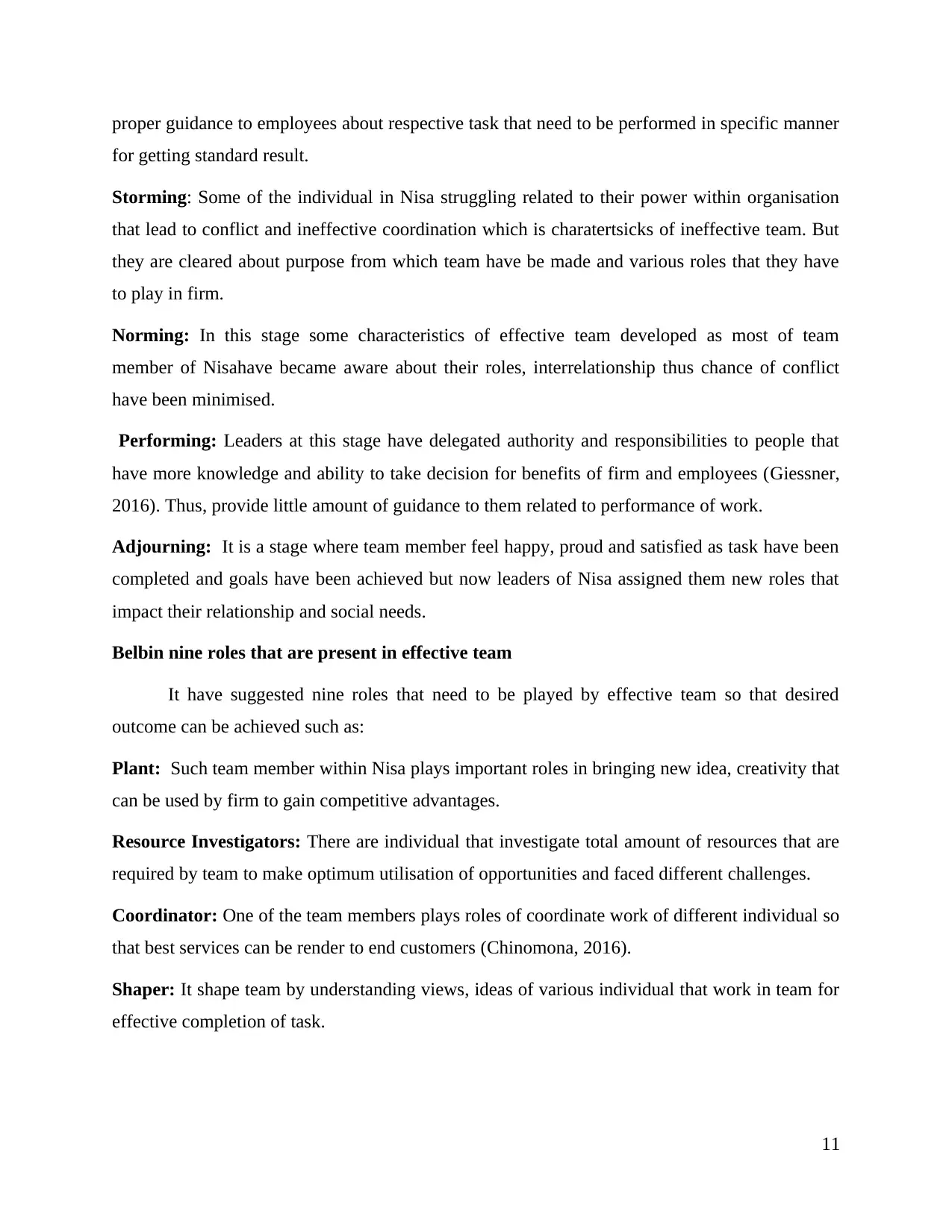
proper guidance to employees about respective task that need to be performed in specific manner
for getting standard result.
Storming: Some of the individual in Nisa struggling related to their power within organisation
that lead to conflict and ineffective coordination which is charatertsicks of ineffective team. But
they are cleared about purpose from which team have be made and various roles that they have
to play in firm.
Norming: In this stage some characteristics of effective team developed as most of team
member of Nisahave became aware about their roles, interrelationship thus chance of conflict
have been minimised.
Performing: Leaders at this stage have delegated authority and responsibilities to people that
have more knowledge and ability to take decision for benefits of firm and employees (Giessner,
2016). Thus, provide little amount of guidance to them related to performance of work.
Adjourning: It is a stage where team member feel happy, proud and satisfied as task have been
completed and goals have been achieved but now leaders of Nisa assigned them new roles that
impact their relationship and social needs.
Belbin nine roles that are present in effective team
It have suggested nine roles that need to be played by effective team so that desired
outcome can be achieved such as:
Plant: Such team member within Nisa plays important roles in bringing new idea, creativity that
can be used by firm to gain competitive advantages.
Resource Investigators: There are individual that investigate total amount of resources that are
required by team to make optimum utilisation of opportunities and faced different challenges.
Coordinator: One of the team members plays roles of coordinate work of different individual so
that best services can be render to end customers (Chinomona, 2016).
Shaper: It shape team by understanding views, ideas of various individual that work in team for
effective completion of task.
11
for getting standard result.
Storming: Some of the individual in Nisa struggling related to their power within organisation
that lead to conflict and ineffective coordination which is charatertsicks of ineffective team. But
they are cleared about purpose from which team have be made and various roles that they have
to play in firm.
Norming: In this stage some characteristics of effective team developed as most of team
member of Nisahave became aware about their roles, interrelationship thus chance of conflict
have been minimised.
Performing: Leaders at this stage have delegated authority and responsibilities to people that
have more knowledge and ability to take decision for benefits of firm and employees (Giessner,
2016). Thus, provide little amount of guidance to them related to performance of work.
Adjourning: It is a stage where team member feel happy, proud and satisfied as task have been
completed and goals have been achieved but now leaders of Nisa assigned them new roles that
impact their relationship and social needs.
Belbin nine roles that are present in effective team
It have suggested nine roles that need to be played by effective team so that desired
outcome can be achieved such as:
Plant: Such team member within Nisa plays important roles in bringing new idea, creativity that
can be used by firm to gain competitive advantages.
Resource Investigators: There are individual that investigate total amount of resources that are
required by team to make optimum utilisation of opportunities and faced different challenges.
Coordinator: One of the team members plays roles of coordinate work of different individual so
that best services can be render to end customers (Chinomona, 2016).
Shaper: It shape team by understanding views, ideas of various individual that work in team for
effective completion of task.
11
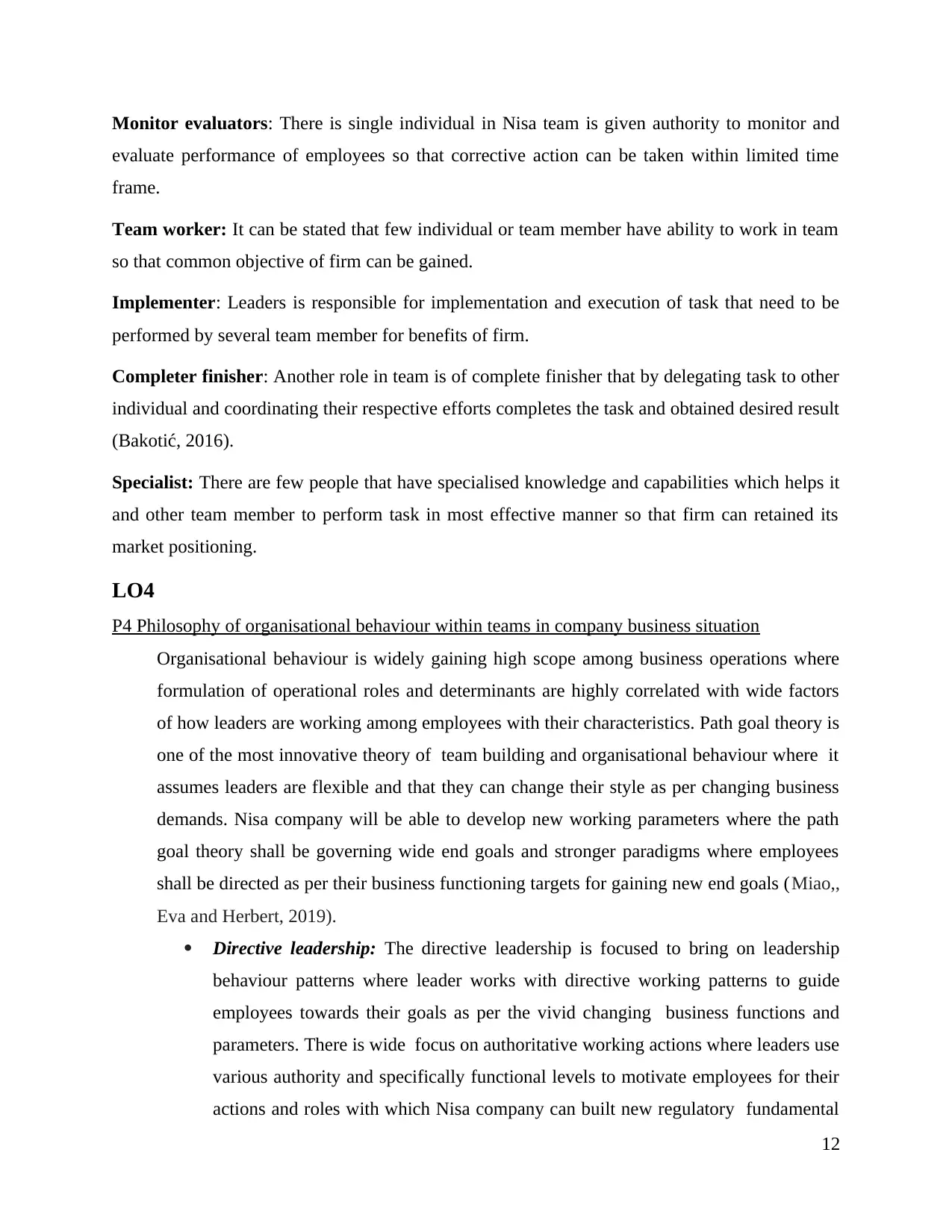
Monitor evaluators: There is single individual in Nisa team is given authority to monitor and
evaluate performance of employees so that corrective action can be taken within limited time
frame.
Team worker: It can be stated that few individual or team member have ability to work in team
so that common objective of firm can be gained.
Implementer: Leaders is responsible for implementation and execution of task that need to be
performed by several team member for benefits of firm.
Completer finisher: Another role in team is of complete finisher that by delegating task to other
individual and coordinating their respective efforts completes the task and obtained desired result
(Bakotić, 2016).
Specialist: There are few people that have specialised knowledge and capabilities which helps it
and other team member to perform task in most effective manner so that firm can retained its
market positioning.
LO4
P4 Philosophy of organisational behaviour within teams in company business situation
Organisational behaviour is widely gaining high scope among business operations where
formulation of operational roles and determinants are highly correlated with wide factors
of how leaders are working among employees with their characteristics. Path goal theory is
one of the most innovative theory of team building and organisational behaviour where it
assumes leaders are flexible and that they can change their style as per changing business
demands. Nisa company will be able to develop new working parameters where the path
goal theory shall be governing wide end goals and stronger paradigms where employees
shall be directed as per their business functioning targets for gaining new end goals (Miao,,
Eva and Herbert, 2019).
Directive leadership: The directive leadership is focused to bring on leadership
behaviour patterns where leader works with directive working patterns to guide
employees towards their goals as per the vivid changing business functions and
parameters. There is wide focus on authoritative working actions where leaders use
various authority and specifically functional levels to motivate employees for their
actions and roles with which Nisa company can built new regulatory fundamental
12
evaluate performance of employees so that corrective action can be taken within limited time
frame.
Team worker: It can be stated that few individual or team member have ability to work in team
so that common objective of firm can be gained.
Implementer: Leaders is responsible for implementation and execution of task that need to be
performed by several team member for benefits of firm.
Completer finisher: Another role in team is of complete finisher that by delegating task to other
individual and coordinating their respective efforts completes the task and obtained desired result
(Bakotić, 2016).
Specialist: There are few people that have specialised knowledge and capabilities which helps it
and other team member to perform task in most effective manner so that firm can retained its
market positioning.
LO4
P4 Philosophy of organisational behaviour within teams in company business situation
Organisational behaviour is widely gaining high scope among business operations where
formulation of operational roles and determinants are highly correlated with wide factors
of how leaders are working among employees with their characteristics. Path goal theory is
one of the most innovative theory of team building and organisational behaviour where it
assumes leaders are flexible and that they can change their style as per changing business
demands. Nisa company will be able to develop new working parameters where the path
goal theory shall be governing wide end goals and stronger paradigms where employees
shall be directed as per their business functioning targets for gaining new end goals (Miao,,
Eva and Herbert, 2019).
Directive leadership: The directive leadership is focused to bring on leadership
behaviour patterns where leader works with directive working patterns to guide
employees towards their goals as per the vivid changing business functions and
parameters. There is wide focus on authoritative working actions where leaders use
various authority and specifically functional levels to motivate employees for their
actions and roles with which Nisa company can built new regulatory fundamental
12
⊘ This is a preview!⊘
Do you want full access?
Subscribe today to unlock all pages.

Trusted by 1+ million students worldwide
1 out of 16
Related Documents
Your All-in-One AI-Powered Toolkit for Academic Success.
+13062052269
info@desklib.com
Available 24*7 on WhatsApp / Email
![[object Object]](/_next/static/media/star-bottom.7253800d.svg)
Unlock your academic potential
Copyright © 2020–2025 A2Z Services. All Rights Reserved. Developed and managed by ZUCOL.





